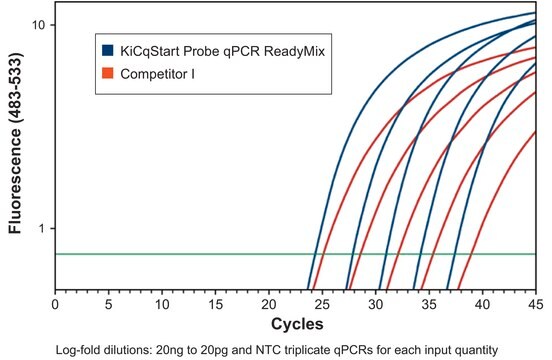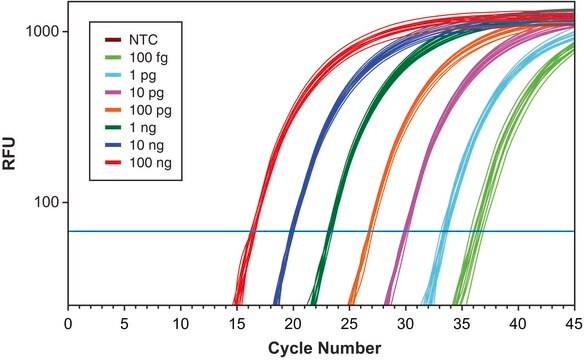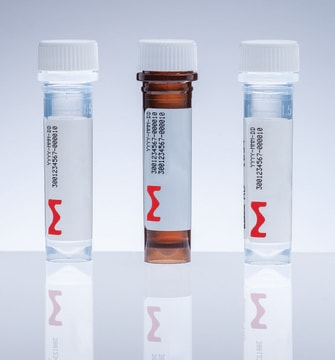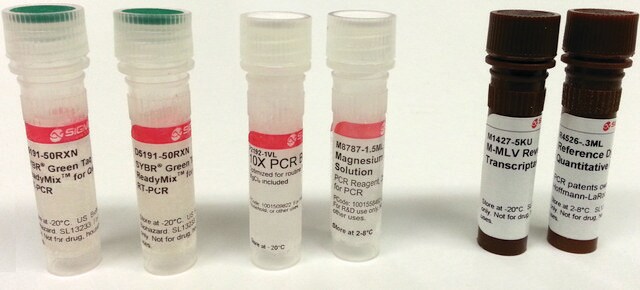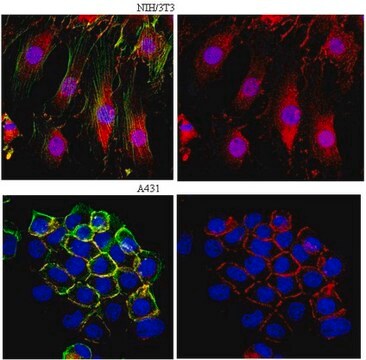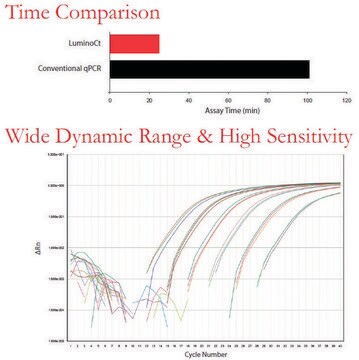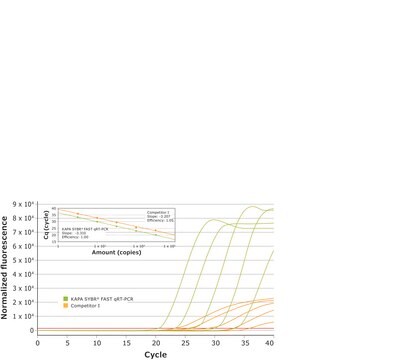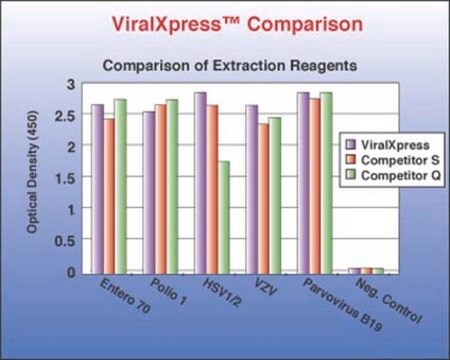KCQS07
KiCqStart® One-Step Probe RT-qPCR ReadyMix™
for Bio-Rad, Cepheid, Eppendorf, Illumina, Corbett, and Roche systems
Synonym(s):
KiCqStart® One Step Probe RT-qPCR Readymix™
About This Item
Recommended Products
form
liquid
usage
sufficient for 500 reactions
feature
dNTPs included
hotstart
storage condition
protect from light
technique(s)
qPCR: suitable
color
light blue
input
purified RNA
compatibility
Bio-Rad CFX384
Bio-Rad CFX96
Bio-Rad MJ Chromo4
Bio-Rad MJ Opticon 2
Bio-Rad MJ Opticon
Bio-Rad MiniOpticon
Eppendorf® Mastercycler ep realplex2 s
Eppendorf® Mastercycler ep realplex
Illumina Eco qPCR
Qiagen Corbett Rotor-Gene 3000
Qiagen Corbett Rotor-Gene 6000
Qiagen Corbett Rotor-Gene Q
Roche LightCycler 480
detection method
probe-based
shipped in
dry ice
storage temp.
−20°C
Looking for similar products? Visit Product Comparison Guide
General description
KiCqStart® One-Step Probe RT-qPCR ReadyMix™ contains all required components for RT-qPCR except RNA template and probe. It is compatible with all dual-labeled probe chemistries. The reverse transcriptase is an engineered M-MLV with reduced RNase H activity and improved activity and stability at higher temperatures. The use of higher temperatures (50 to 55°C) for the first-strand step of one-step RT-qPCR provides higher specificity for primer annealing and disruption of RNA secondary structure that can interfere with cDNA synthesis.
KiCqStart® One-Step Probe RT-qPCR ReadyMix™ is highly resistant to PCR inhibitors. A key component of the ReadyMix™ is an ultra-pure, highly processive, thermostable DNA polymerase that is combined with high avidity monoclonal antibodies. This provides an extremely stringent automatic hot-start that minimizes the potential for primer-dimer and other non-specific PCR artifacts. The light blue color of the inert dye simplifies reaction assembly in white, or clear, plates and helps to minimize pipetting or mixing errors. The dye does not interfere with qPCR performance or affect the stability of the product.
Application
- in quantitative real-time polymerase chain reaction (qRT-PCR) for gene expression studies
- in cell type-specific transcript analysis for determining the cycle threshold (Ct) value
- for severe acute respiratory syndrome coronavirus 2 (SARS-CoV-2) RNA detection from nasopharyngealand oropharyngeal swabs
- for amplification of reverse-transcribed cDNA
Features and Benefits
- Assay results in as little as 33 minutes
- Highly efficient and sensitive real-time PCR results
- Little/no optimization required
Components
packaging:
500 reactions* = 5 X 1 mL tubes
*number of reactions based on a 20uL volume
Other Notes
- Bio-Rad® CFX384™
- Bio-Rad CFX96™
- Bio-Rad MiniOpticon™
- Bio-Rad/MJ Chromo4™
- Bio-Rad/MJ Opticon 2
- Bio-Rad/MJ Opticon™
- Cepheid SmartCycler®
- Eppendorf Mastercycler® ep realplex
- Eppendorf Mastercycler ep realplex2 s
- Illumina Eco qPCR
- Qiagen/Corbett Rotor-Gene® 3000
- Qiagen/Corbett Rotor-Gene 6000• Qiagen/Corbett Rotor-Gene Q
- Roche LightCycler® 480
Legal Information
recommended
related product
Storage Class Code
12 - Non Combustible Liquids
WGK
WGK 3
Flash Point(F)
Not applicable
Flash Point(C)
Not applicable
Choose from one of the most recent versions:
Already Own This Product?
Find documentation for the products that you have recently purchased in the Document Library.
Customers Also Viewed
Articles
Viral RNA Extraction Buffer (VRE100) and related reagents for qRT-PCR and additional viral RNA analyses.
RT-qPCR products combine the effective of Reverse Transcriptase with hot-start taq-directed antibody in convenient ReadyMixes for probe-based or SYBR® Green based applications.
PCR assay guide navigates you through primer validation and other assay optimization factors to ensure high sensitivity and specificity for optimum DNA/ RNA quantification.
One approach to the analysis of gene expression is to measure the concentration of mRNA of a gene. There are several challenges to such analyses, such as the differences in half life between different transcripts, the temporal patterns of transcription and the lack of correlation between mRNA and protein.
Protocols
KiCqStart One-Step Probe RT-qPCR ReadyMix is a ready-to-use, highly sensitive master mix for reverse transcription quantitative PCR (RT-qPCR) of RNA templates using hybridization probe detection chemistries such as TaqMan 5'-hydrolysis probes on real-time PCR systems.
Coronavirus qPCR Primer and probe sets for the detection of SARS-CoV-2 (Corona Virus), with additional real-time RT-PCR, RT-qPCR and supporting reagents available.
Related Content
RT-qPCR, or quantitative reverse transcription PCR, combines the effects of reverse transcription and quantitative PCR or real-time PCR to amplify and detect specific targets. RT-qPCR has a variety of applications including quantifying gene expression levels, validating RNA interference (RNAi), and detecting pathogens such as viruses.
Our team of scientists has experience in all areas of research including Life Science, Material Science, Chemical Synthesis, Chromatography, Analytical and many others.
Contact Technical Service